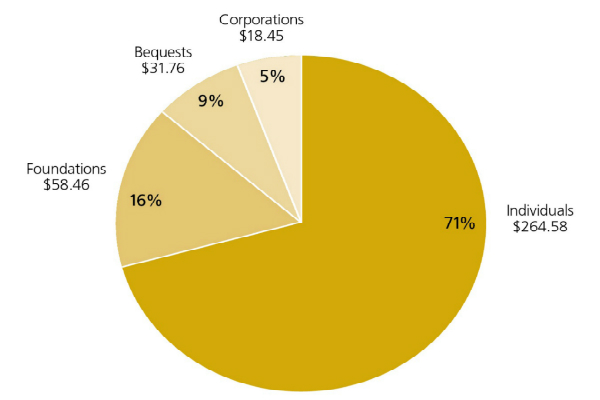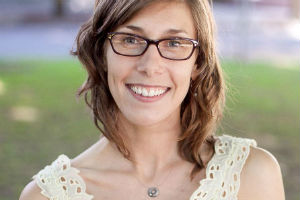Donors dug deep during 2015 and reached record highs in charitable giving for a second consecutive year hitting $373.25 billion, up 4.1 percent from 2014, according to preliminary estimates released today. It’s the first time in a decade that giving reached double-digit growth during a two-year period at 10.1 percent.
The statistics are from “Giving USA 2016: The Annual Report on Philanthropy for the Year 2015,” a publication of Giving USA Foundation written and researched by the Indiana University Lilly Family School of Philanthropy in Indianapolis, Ind. It’s the first comprehensive estimate of giving during 2015, based on econometric models and Internal Revenue Service (IRS) data. It also revises preliminary estimates released a year ago for 2014.
Giving USA estimates giving only from U.S.-based individuals and institutions to U.S.-based 501(c)(3) nonprofit organizations.
The revised inflation-adjusted estimate for giving in 2014 was $359.04 billion, with current-dollar growth of 7.8 percent, or 6.1 percent when adjusted for inflation. That number added to the 4.1 percent for 2015 is the 10.1 percent growth figure.
After two years of declines, giving to international affairs had the largest increase compared to 2014, at 17.5 percent, or 17.4 percent inflation adjusted, to $15.75 billion, followed by:
- Education, 8.9 percent/8.8 percent adjusted for inflation, $57.48 billion;
- Arts, culture, and humanities, 7 percent/6.8 percent, $17.07 billion;
- Environmental and animal, 6.2 percent/6.1 percent, $10.68 billion;
- Public-society benefit, 6 percent/5.9 percent, $26.95 billion;
- Human services, 4.2 percent/4.1 percent, $45.21 billion;
- Religion, 2.7 percent/2.6 percent, $119.3 billion;
- Health, 1.3 percent/1.2 percent, $29.81 billion;
- Individuals, -1.6 percent, -1.8 percent, $6.56 billion; and,
- Foundations, -3.8 percent, -4 percent, $42.26 billion.
Unallocated giving totaled $2.18 billion in 2015. This is considered the difference between giving by source and by use in any particularly year. It includes the difference between itemized deductions by individuals carried over from previous years. It is the tax year in which a gift is claimed by the donor and the year when the organization reports it as revenue may differ.
Charitable donations have hovered around 2 percent of Gross Domestic Product (GDP) for many years. Charitable giving during 2015 was 2.1 percent, the same as 2014 and slightly more than the 40-year average of 1.9 percent.
Growth in charitable donations has outperformed growth in GDP between 2010 and 2015, according to Jeffrey Byrne, chairman of The Giving Institute and president and CEO of Jeffery D. Byrne + Associates. Inflation-adjusted total giving grew at an annualized rate of 3.6 percent during that period while GDP growth grew at an average rate of 2 percent, he said.
The past two years represent the highest and second-highest totals for giving – and the third- and fourth-largest percentage increases in giving – during the past 10 years, adjusted for inflation, according to Amir Pasic, Ph.D., the Eugene R. Tempel Dean of the Lilly Family School. “The share of total giving going to each type of recipient was virtually the same in 2015 as it was in 2014. During and after the recession some donors redirected donations to assist with pressing needs. The fact that the portion of the giving ‘pie’ destined for various subsectors has been largely consistent for the past two years suggests that giving among the broad destination categories may be stabilizing,” he said.
As usual, individual giving made up the largest portion of the all donations at 71 percent, or $264.58 billion. Giving by individuals increased 3.8 percent, or 3.7 percent when inflation adjusted. Itemized giving comprised 82 percent of the total estimate by individuals. Giving by itemizing and non-itemizing households increased 4.1 percent and 2.5 percent, respectively.
Giving by foundations had the biggest increase last year, up by 6.5 percent, or 6.3 percent inflation adjusted, to $58.46 billion. Grantmaking by community foundations increased 7.4 percent, while giving by operating foundations and independent foundations increased 8.1 percent and 6 percent, respectively.
Giving by corporations was up 3.9 percent/3.8 percent for inflation, to $18.45 billion, which is includes in-kind contributions, grants and gifts by corporate foundations. Corporate foundation grantmaking was estimated at $5.43 billion, up by 5.4 percent compared to 2014.
Giving by bequest totaled $31.76 billion, up 2.1 percent from 2014, or 1.9 percent when adjusted for inflation.
“For all the talk about giving and GDP or the S&P 500, the more telling statistic is giving as a percentage of disposable personal income,” said Steve MacLaughlin, director of analytics at Blackbaud. “This has been stuck at 2 percent for many years now,” he said. With 71 percent of giving now coming from individuals that increases the importance of disposable income in charitable giving trends, he added.
Record highs for arts as well as environmental and animal organizations reflect “changes in donor affinity and improved fundraising practices,” MacLaughlin said. High growth rates in bequests show that planned giving remains a significant opportunity for charities.
Part of the growth in education and arts is that a number of organizations also have initiated larger capital campaigns, said W. Keith Curtis, president of The Curtis Group, and chairman of the Giving USA Foundation. The Nepal earthquake wasn’t necessarily a driver of growth in international affairs but the sector had several years of declines. “To some degree, it’s taken a little longer to catch up to some of the other areas,” he said.
Curtis said that 2014 was the first time that the assets of the three major commercial donor-advised funds (DAF) exceeded those held by community foundations. Giving to DAFs can fall under giving to foundations, through community foundations, or public-society benefit, through commercial DAFs. The growth in establishing DAFs with the big three commercial DAFs could be taking away from giving foundations, which had been among the fastest-growing subsectors in recent years.
Patrick Rooney, Ph.D., associate dean for academic affairs and research at the Lilly Family Schools, called the two-year growth of more than 10 percent remarkable given the overall slow growth in the economy the past two years. He’s optimistic that the economy will continue to grow and not see a dip. “In some ways it’s easier to sustain a slower, steadier growth than real rapid growth in the economy,” Rooney said. “While less exciting, it’s probably more stable and sustainable,” he said.
The last time philanthropy grew at a double-digit pace over two years was 2004-05, Rooney said, adding that was probably the last time GDP grew at a robust rate for two years. “You definitely see a correlation between total giving and GDP growth.”











